Clasp Dentures Care
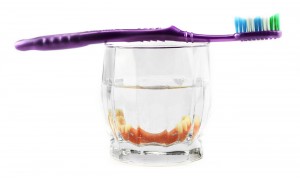
Modern removable dentures are aesthetic, strong and durable.
How to care for arch prostheses so that they serve long and efficiently?
An important role in maintaining the attractiveness of the design, safety for the oral mucosa and maximum service life is played by the proper care of the prosthesis.
With careful maintenance of the design, the prosthesis can last 5 years or more.
Caring for clasp dentures is quite simple and takes very little time.
This procedure should be one of the most important, because during the day on the structure during the day a plaque of bacteria develops, which contributes to the appearance of halitosis and leads to the development of inflammatory diseases of the oral cavity.
During sleep, salivation is reduced, which reduces its protective effect on the structure. As a result, bacterial plaque forms on the surface of the structure, gums and real teeth, which provokes various inflammatory diseases of the oral cavity.
In this regard, hygiene procedures and cleaning of the structure should be carried out at least twice a day (morning and night).
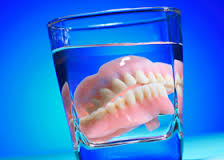
- The denture must also be cleaned of plaque and food particles. This should be done using a toothbrush with paste.
- After each meal, the mouth must be rinsed with running water.
- Daily cleaning of the structure is carried out using special solutions and pastes designed to care for removable dentures.
- When cleaning the prosthesis, the use of abrasive products is not recommended.
Wear reasons
- The use of abrasive substances. When a denture is cleaned with toothpaste with a whitening effect on the structure, scratches may appear that contribute to the accumulation of bacterial plaque on the prosthesis.
- Inadequate maintenance of the structure. A dirty prosthesis often causes it to wear out quickly and causes inflammation in the oral cavity.
- When smoking, drinking coffee or strong tea, dental structures turn yellow, and a hard-to-remove brown coating forms on them.
Complex cleansing
The effectiveness of prosthesis care depends on complex cleansing.
The main criterion for cleansing is the hygiene of the prosthesis. It should be the same as at the time of its manufacture.
Water rinse
It is recommended to flush the structure after each meal. It is better to use fresh boiled water for rinsing, because it does not contain harmful microorganisms that can get on the prosthesis.
This method for high-quality cleansing is not enough.
Toothbrush Cleansing
It is carried out to remove plaque and stuck food particles between artificial teeth and at the junction of parts of the structure.
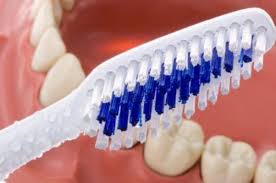
Cleaning is carried out using special or regular toothpaste in the same movements as real teeth. When cleaning, special attention is paid to the surface of the structure that is adjacent to the mucous membranes.
Then the prosthesis must be thoroughly washed with water and for disinfection it is recommended to immerse in a special solution for disinfection.
Disinfectant Cleansing
At least once a day, the treatment of the structure in a special solution is required, which is sold ready-made or prepared using special tablets.
The design is placed in the prepared solution for 5 to 10 minutes. This time is enough to remove bacterial plaque and food debris from the prosthesis.
This solution protects the metal parts of the structure from corrosion.
Once a week, the design is processed in a special bio-solution, which removes difficult to remove stained spots, food debris in hard to reach areas of the prosthesis.
Professional Cleansing
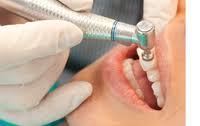
It is carried out in a dental clinic with poor-quality cleaning of the structure using the above methods.
As a result of professional cleaning of the structure, solid deposits are eliminated.
This rule applies to professional cleaning of the oral cavity.
Oral care with a prosthesis
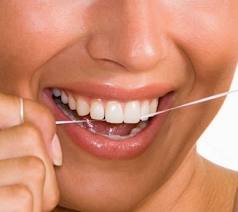
It must be borne in mind that before putting on the structure, it is necessary to carry out oral hygiene.
Teeth are cleaned of bacterial plaque with a brush and toothpaste, interdental spaces are removed from food particles using floss (dental floss) or a special brush. It is important to thoroughly clean the teeth at the point of contact with the gums.
Such measures can restore blood circulation and avoid inflammation of the gums, to rest the supporting teeth and jaws.
Do not forget that the healthier the gums and jaw, the better they keep their shape, which means that the longer you feel comfortable using the prosthesis.
Video: “Professional teeth whitening methods”
Nutrition
- When using the clasp structure in the first time after installation, while adaptation to the structure takes place, it is necessary to eat only soft food.
- Do not bite your food with your front teeth. Chew food only with the help of the posterior teeth, evenly distributing it on the right and left jaw.
- When you get used to the prosthesis, you can gradually switch to the usual food, but nevertheless, for the successful functioning and durability of the clasp prosthesis, it is necessary to minimize or eliminate solid, sticky and viscous food from the diet.
- When chewing solid food, an artificial tooth may break off and cause structural damage.
- You can train your chewing skills by eating fruits or vegetables cut into small pieces.
- Viscous and sticky food can stick to the prosthesis and cause it to break.
Storage
Clasp denture is not recommended to be removed at night, especially with periodontal disease, if a special splint clasp construction is installed.
If you want to remove the structure for a while, then it must be thoroughly cleaned, dried and placed in a dry case.
Correction
You can not carry out the correction of the removable structure yourself.
- The prosthesis must be protected from exposure to high temperatures, as well as chemical and mechanical damage.
- When cracks appear, it is forbidden to use the structure and, moreover, to independently repair it.
Occupational Examination
At least once every six months, the patient should undergo a professional examination at the dentist.
The doctor will examine the oral cavity and, if necessary, conduct a relocation of the prosthesis.In the process of using the structure, atrophy of the bone tissue and mucous membrane occurs, as a result, an empty space appears under the structure and gum, which leads to incomplete adherence of the prosthetic bed to the gum. This leads to an uneven distribution of the chewing load between the mucosa and the abutment teeth.
If the design is not relocated in time, then loss of supporting teeth may occur and the prosthesis will become unusable.
If there are complaints of burning sensation, increased dry mouth, skin rashes, and other unusual symptoms in the first time after the installation of the prosthesis, it is urgent to see an allergist for examination for allergies.